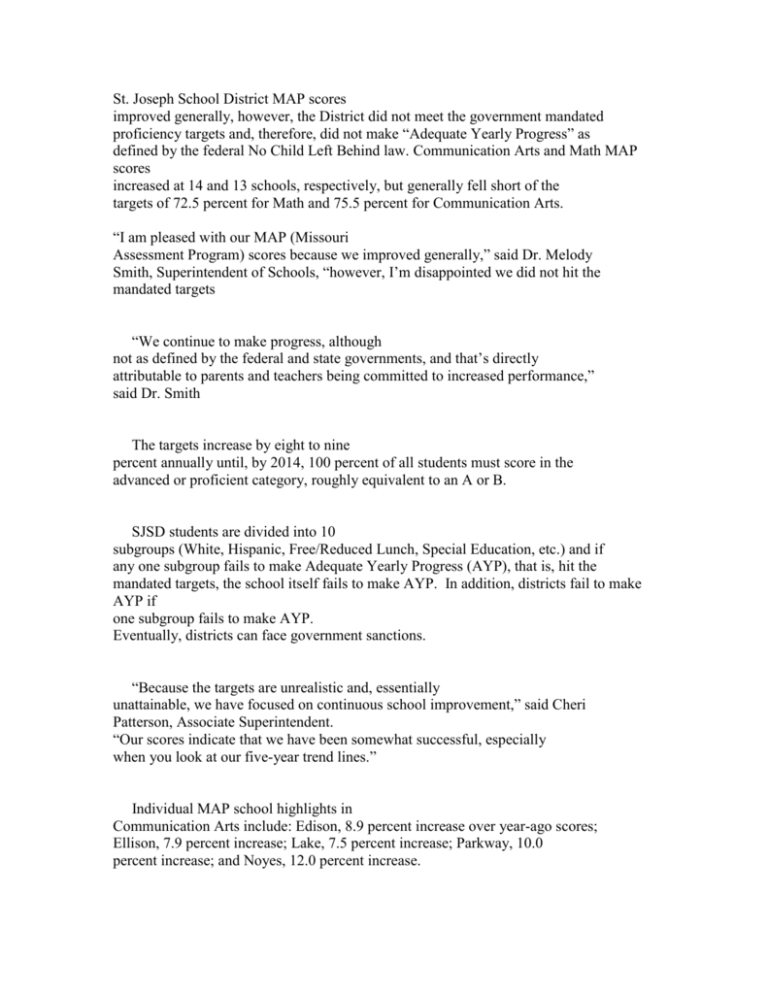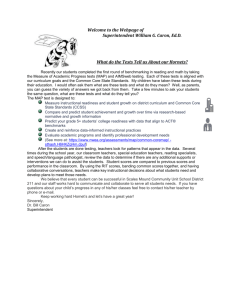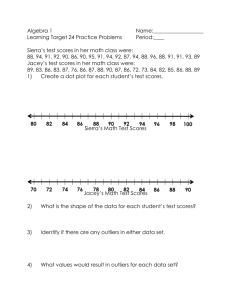St. Joseph School District MAP scores improved generally, however
advertisement

St. Joseph School District MAP scores improved generally, however, the District did not meet the government mandated proficiency targets and, therefore, did not make “Adequate Yearly Progress” as defined by the federal No Child Left Behind law. Communication Arts and Math MAP scores increased at 14 and 13 schools, respectively, but generally fell short of the targets of 72.5 percent for Math and 75.5 percent for Communication Arts. “I am pleased with our MAP (Missouri Assessment Program) scores because we improved generally,” said Dr. Melody Smith, Superintendent of Schools, “however, I’m disappointed we did not hit the mandated targets “We continue to make progress, although not as defined by the federal and state governments, and that’s directly attributable to parents and teachers being committed to increased performance,” said Dr. Smith The targets increase by eight to nine percent annually until, by 2014, 100 percent of all students must score in the advanced or proficient category, roughly equivalent to an A or B. SJSD students are divided into 10 subgroups (White, Hispanic, Free/Reduced Lunch, Special Education, etc.) and if any one subgroup fails to make Adequate Yearly Progress (AYP), that is, hit the mandated targets, the school itself fails to make AYP. In addition, districts fail to make AYP if one subgroup fails to make AYP. Eventually, districts can face government sanctions. “Because the targets are unrealistic and, essentially unattainable, we have focused on continuous school improvement,” said Cheri Patterson, Associate Superintendent. “Our scores indicate that we have been somewhat successful, especially when you look at our five-year trend lines.” Individual MAP school highlights in Communication Arts include: Edison, 8.9 percent increase over year-ago scores; Ellison, 7.9 percent increase; Lake, 7.5 percent increase; Parkway, 10.0 percent increase; and Noyes, 12.0 percent increase. Individual school highlights in Math include: Coleman, 8.6 percent increase over year-ago scores; Lafayette, 11.8 percent increase; Lake, 20.5 percent increase; Parkway, 10.9 percent increase. This year, no SJSD schools made Adequate Yearly Progress. And that means changes for some parents. Pershing (which scored above the state average) and Hyde (which scored above the District average) Elementary Schools did not make AYP this year, which means that, according to No Child Left Behind, they will not be able to accept transfer students from Title I schools that did not meet AYP. Last year, Pershing and Hyde were among the allowable “receiving” schools and some parents were able to send their students there, with transportation provided. That will not be an option at those two schools this year. Further, this year, the only schools that may receive transfer or choice students from Title I schools are: Coleman, Field, Noyes and Pickett. Letters have been sent to parents of students at Edison, Hall, Hosea, Humboldt, Lake and Lindbergh advising them of their options. “While No Child Left Behind was well-intentioned, it is incredibly confusing for school districts and, most importantly, for parents,” said Mrs. Patterson. “We respectfully encourage parents to get involved in their schools and experience for themselves that their children are receiving a quality education. “A single high-stakes test does not truly measure a quality education,” she said. “Simply look at the improvement gains at Edison, Lake and Noyes, for example, and you can see that these are far from being ‘failing schools.’” In addition, Mrs. Patterson said that the District’s commitment to continuous school improvement has paid off for some sub-groups, as well, including the District’s 60 percent-plus Free and Reduced Lunch (FRL) population. Since 2008, the Communication Arts scores of FRL students have improved by 4.8 percent, while Communication Arts scores of Black students have increased by 5.8 percent. Math scores for FRL students have increased 6.6 percent since 2008, and Black student Math scores have climbed 11.3 percent. The Communication Arts scores of White students have increased 3.7 percent since 2008, while the Math scores of White students have increased 3.5 percent. The sub-group scores for English Language Learners and Special Education students, however, have decreased since 2008. Click Here For the Chart.






